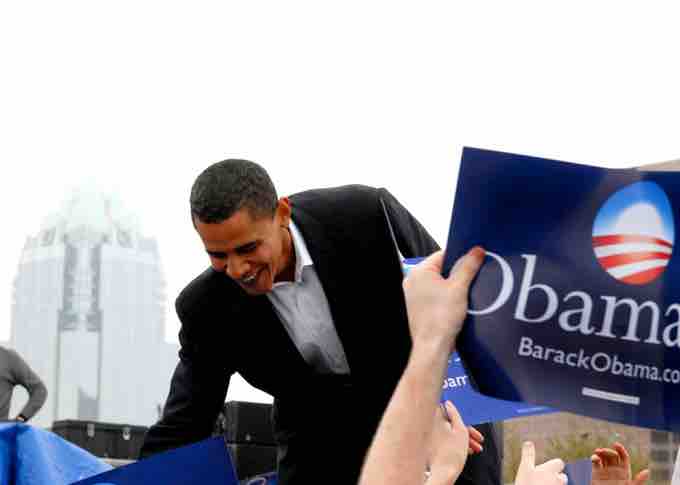Voting
Voting is the most prominent form of political participation, and in fact, for many people, it is the primary means of participating in politics. A unique and special political act, voting allows for more people's views to be represented than any other activity. Every citizen gets one vote that counts equally . Expanded voter registration means that more and more people have been able to participate, and voter turnout trends indicate how many people exercise their right to vote as a primary means of political participation.

History of Voting in the United States
This painting from 1846 depicts a polling judge administering an oath to a voter. Since America's founding, voting has been a primary avenue for citizen participation in politics.
Voter Registration: The First Step to Participation
In order to participate in voting, citizens must be registered. To register, citizens must meet eligibility requirements and have filed the necessary paperwork that permits them to vote in a given locality. Eligibility requirements require voters to be eighteen years of age, and states can enforce residency requirements that mandate the number of years a person must live in a place before being eligible to vote. The composition of the electorate has changed radically throughout American history. The pool of eligible voters has expanded from primarily white, male property owners at the founding, to include black men after the Civil War, women after 1920, and eighteen- to twenty-year-olds after 1971.
Voter registration laws were implemented in the 1860s by states and big cities to ensure that only citizens who met legal requirements could vote. Over time, residency requirements were relaxed. Beginning in the 1980s, some states, including Maine, Minnesota, and Wisconsin, made it possible for people to register on Election Day. Turnout in states that have Election Day registration averages ten points higher than in the rest of the country. The United States is one of the few democracies that requires citizens to register themselves rather than having the government take responsibility for automatically registering them.
Significant steps have been taken to make registration easier, and to ensure more people can participate in elections. In 1993, Congress passed the National Voter Registration Act of 1993, also known as the "motor voter" law, allowing citizens to register at motor vehicle and social service offices. "Motor voter's" success in increasing the ranks of registered voters differs by state depending on how well the program is publicized and executed. Voter registration also has increased as a result of online registration. Rock the Vote (RTV), a nonpartisan youth mobilization organization, established the first online voter registration initiative in 1992 with official backing from the Congressional Internet Caucus. RTV registered over 2 million new voters in 1992, 80% of whom cast a ballot, and signed up over 2.5 million voters in 2008.
Voter Turnout
Over 90 percent of Americans agree with the principle that citizens have a duty to vote. Still, many people do not vote regularly. Social, cultural, and economic factors can keep people from voting, or sometimes barriers to voting are informal. The United States holds a large number of elections, each governed by specific rules and schedules. With so many elections, people can become overwhelmed, confused, or just plain tired of voting.
How many people actually participate in elections often depends on the type of election. A large number of elections are held in the United States every year, including local elections, elections for county and statewide offices, primaries, and general elections. Only a small number of people, generally under one-quarter of those eligible, participate in local, county, and state elections. Midterm elections, in which members of Congress run for office in nonpresidential-election years, normally draw about one-third of eligible voters. Young voters are less likely to turn out in midterm elections than older citizens. In 2010, only about 23 percent of eligible eighteen- to twenty-nine-year-olds cast a ballot. Voter turnout in presidential elections is generally higher than for lower-level contests; usually more than half the eligible voters cast a ballot .

Voter Turnout by Sex and Age (2008)
This is a chart illustrating voter turnout by sex and age for the 2008 U.S. Presidential Election using data from the U.S. Census Bureau. Notice the higher turnout rates for women, and for older people.
Voter turnout in the current era has not fluctuated much since voting participation during universal suffrage in 1920. Forty-nine percent of the voting-age public cast a ballot in the 1924 presidential contest, the same percentage as in 1996. Turnout in presidential elections in the 1960s was over 60 percent. More voters were mobilized during this period of political upheaval and people focused on issues of race relations, social welfare, and the Vietnam War. Turnout was lower in the 1980s and 1990s, when the political climate was less tumultuous. There has been a steady increase in turnout since the 2000 presidential election, in which 51 percent of the voting-age public cast a ballot. Turnout in the 2008 election was greater than usual, at 57 percent .

2008 Election
Participation in the 2008 presidential election was greater than usual, as people were motivated by the open race and the candidate choices.